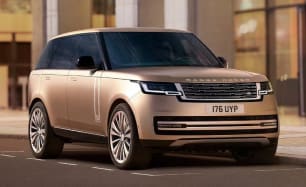There’s a more practical wagon-bodied version offered in Europe, contributing to the Enyaq’s success as a family car but the Enyaq coupe still bursts with smart storage.
In fact, it’s fairer to think of this Enyaq RS as more of a raised sedan, a slightly taller-riding electric version of the Skoda Superb, rather than a 'coupe'.
The Skoda Enyaq has a huge 570-litre boot that puts it at the pointy end of the class (Tesla’s 854L Model Y claim is fanciful, including underfloor storage and counting all the way to the roof).
Plus, being a Skoda, the Enyaq ships with 'Simply Clever' touches like four shopping bag hooks, four tie-down points, extensive cargo net system, two amazingly useful Velcro boot dividers and segmented underfloor storage for supplied Mode 2 and 3 charging cables. There’s even a hook on the parcel shelf to hold the false floor up. The only miss is a lack of spare wheel.
The backrest folds flat in a 60/40 split and this can be done from the back seat with remote levers. There’s also a ski-port pass-through that doubles as an armrest in the back seats.
Accommodation in the rear is great, even for those about six foot. I was comfortable sitting behind my driving position at 188cm, with good knee room, toe space and headroom.
Amenity includes a separate climate zone, two USB-C chargers, nifty pull-up and clip-in rear sunshades, a removable centre box (so you can have a fully flat floor) and two cupholders in the armrest. Materials are mostly hard, though there is a squishy armrest on the door card.
The only negative in the back — especially apparent in harsh Australian summers — is the heat radiating from the standard glass roof. There is a manually-installable sunshade available from Skoda.
The Skoda Enyaq has ISOFIX anchors on both outboard rear seats and the same number of top tether anchors. The top tethers are easy to access with no covers to get in the way.
It has doors that open quite wide, but not quite to 90 degrees, and the low roof means door apertures are a little awkward. Also, because the door cladding comes all the way down and the car is functionally quite low, care is required around tall kerbs.
You’ll notice in the front door card that Skoda’s signature umbrellas are nestled into the hole the armrest leaves, which is a great touch.
The bucket seats are 10-way power adjustable with two-position memory and heating. It is easy to get comfortable with the reach and height adjustable steering wheel falling perfectly to the hands, being especially accommodating for taller drivers.
Practical touches include felt-lined door bins, a storage cubby beneath the centre console and shift-by-wire gear selector, half-width glove box, multi-tiered storage below an adjustable centre armrest, adjustable size cupholders and plenty of odds and ends storage.
Technology is straightforward and runs through a responsive 13.0-inch touchscreen. Skoda’s software is fine but most will end up using the consistent wireless Apple CarPlay or Android Auto in the Enyaq.
Thankfully, doing so doesn’t hamper the screen’s shortcut buttons. At the bottom there’s still quick temperature adjustment and heated seat controls, shortcuts to the home screen, further climate, phone, media menus and more.
Skoda has kept a few clips of physical buttons, too, some below the screen shortcut to the drive assist, drive modes, park assist, hazard lights, climate control and demisters, while headlights are down and to the right of the steering wheel. Simple stuff, but not to be taken for granted anymore.







